The Greater Simonsberg Conservancy T: 079 276 36 38 F: 086 6613746 E-mail: conservancy@delvera.co.za
|
Flora and Fauna The Conservancy
is home to more than 60 bird species, more than 120
indigenous plants, at least 24 geophytic plant species
(bulbs/bolplante) most of which flower during Spring,
a wide variety of trees and larger shrubs, plus a range
of reptiles - such as tortoises, lizards and snakes
- and mammals, including vlei rats, striped mice, duikers,
dassies and porcupines. Bigger animals reside in the
nature reserves and parks within the Conservancy bounderies. |
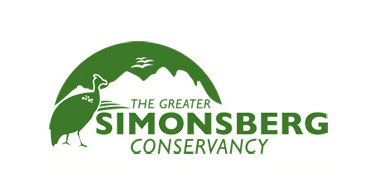
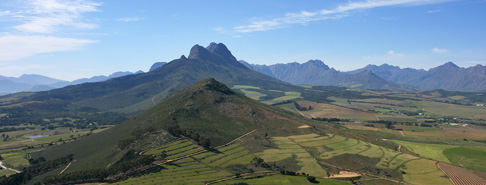
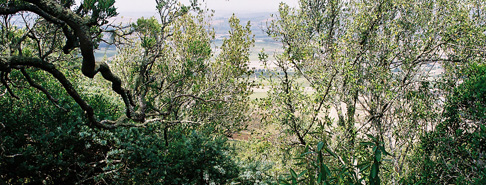
Map of the Greater Simonsberg Conservancy
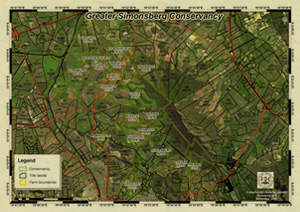
Structure of GSC and staff: See pdf
Partners:
Cape Nature
WWF-BWI
Landcare
Cape Winelands District Municipality
Dept of Agriculture
Stellenbosch 360
Stellenbosch Wine Route
Tax exemptions:
Gifts and donations to GSC are exempt from estate duty and donations tax. Donations, gifts and grants made to GSC South Africa are tax deductible in the hands of donors, subject to the limitations prescribed in section 18A of the Income Tax Act.
300 Year old Yellowwood Forest
(Podocarpus
elongates)
Klapmutskop is just 150 hectares
in size but bursting with wildlife and rare
gems. A massive fire in 2000 and the clearance
of alien trees from the slopes of Klapmutskop
led to the discovery on top of the mountain,
of an indigenous yellowwood forest.
The Breederiver Yellowwood trees (Podocarpus
elongates), some of which are 300 years-old,
represent the southernmost patch of the species.
The old yellowwoods frame your path by archways
of branches. Miraculously surviving what nature’s
served up over the years, this small indigenous
forest acts as a stark reminder of why conservation
is so essential. In January 2007, an intense veld fire ravaged
the south-western slopes of Klapmutskop. This
was the fourth fire in 64 years and it was also
the worst. Although the Yellowwood forest was
badly damaged, it survived.
The miracle of fire is that fynbos needs to
burn in order to rejuvenate itself and for the
seeds to germinate. Seeds sometimes lie dormant
in the soil for many years and it is only a
veld fire that will provoke these hidden treasures
to re-sprout and flourish again. For this reason,
it is very important that, after a fire, visitors
keep to the marked paths that are available
to visitors who pay a modest fee for their permit,
of which 25% is ploughed back into the Conservancy. Klapmutskop is botanically significant because
it is a meeting point for three different geological
formations: Sandstone, Granite and Conglomerate
(Magrug Formation). These formations support
different vegetation types; Mountain Fynbos/Afromontane
Forest (Sandstone), Boland Granite, Fynbos (Granite)
and a Mountain
Fynbos-Boland, Granite Fynbos mosaic (Magrug).
Other sponsorships from Cape District Winelands Municipality have assisted with the initial construction of the Simonsberg Environmental Education Centre (SEE Centre) on DelVera farm, which with anticipation will be open in July 2012. The SEE Centre will be an asset to the community of Stellenbosch whereby a myriad of fun activities for school children focusing on key environmental weeks, together with interactive displays and information will be accessible to the public free of charge.
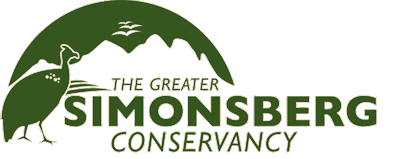
Other projects that the GSC co-ordinate is fire management, eco-tourism, skills training, plant rehabilitation, consulting and provision of conservation services (such as owl boxes). Eco-tourism activities are linked to various service providers, such as horse riding by Equine Sports Centre and hiking and mountain biking through Dirtropia trail centre, where permits are available to the public. We encourage public participation, whereby 25% of the permit fees are ploughed back into conservation.
The GSC is also is involved in active fire management through integrated landowner cooperation, together with firebreaks and staff training. Uncontrolled veld fires are a great threat to biodiversity and is of a great concern to the landowners, who co-ordinate efforts with Stellenbosch Fire Protection Association, Cape Nature and CDWM in controlling run-away fires. Partnerships with BWI (Biodiversity and Wine Initiative), CDWM, Landcare, Cape Nature, Stellenbosch Tourism and WESSA have been beneficial in the establishment and development of the GSC and further partnerships and support are welcomed.
The GSC is one of the few conservancies in the Western Cape that is actively managed by a Conservation Officer and it seeks to deliver professional conservation services to its members and aims to transform this unique part of the Cape Winelands into a pristine natural landscape, which will hopefully become an iconic eco-tourism route for the wider community to enjoy and benefit from.
About us
The Greater Simonsberg Conservancy is situated in the heart of the Cape Winelands along the slopes of the iconic Simonsberg Mountain in Stellenbosch.
The GSC was initially established by private landowners under Cape Nature’s Stewardship Programme as the Klapmutskop Conservancy in 2004, with five founding wine farms (Delheim, Elsenburg, East Hill, Le Bonheur and Warwick) all huddled around the Klapmutskop.
 It has now grown to 27 members in 2012 and is still growing! The farmland area currently covers over 4,866Ha with 1,562Ha designated under conservation (which is approx 32% of the total area).
It has now grown to 27 members in 2012 and is still growing! The farmland area currently covers over 4,866Ha with 1,562Ha designated under conservation (which is approx 32% of the total area).
The GSC is situated in an area that has precious fragments of critically endangered Swartland Shale Renosterveld and Mountain Fynbos. Where there is a wide variety of fauna and flora, including the Cape Leopard (sighted on Tokara Wine Farm), critically endangered Serruria pinnata, endangered Aristea lugens and 300 year old yellow wood forest (Podocarpus elongates) on Klapmutskop.
Efforts in restoration of the natural environment have only been possible through sponsorship and landowner support. The members are actively involved in conservation initiatives on their wine farms and since 2009 until now, when a full time Conservation Officer was employed to manage the conservancy. Over 478Ha of alien invasive plants have been removed with the assistance of funding from Landcare. Further clearing is to continue in the years to come, as this is one of the major threats to water supply, fire management and conservation of biodiversity in the area.

